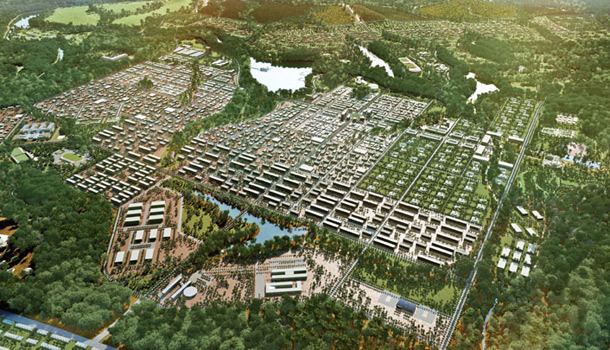Country Equatorial Guinea Climate Aw Area 81.5 km² Province Wele-Nzas Province | Time zone WAT Elevation 454 m Local time Wednesday 1:42 AM Estimated completion 2020 | |
 | ||
Weather 22°C, Wind SE at 2 km/h, 96% Humidity | ||
Oyala (also known as Djibloho) is a city that is being built to serve as the capital of Equatorial Guinea, replacing the city of Malabo. The planned city's location was chosen for its easy access and benign climate. The construction of this new capital has been criticised by the political opposition to President Teodoro Obiang, the driving force behind the initiative. It is located in Wele-Nzas Province, near the town of Mengomeyén.
Contents
- Map of Djibloho Equatorial Guinea
- Location
- Planning and construction
- Urban design
- Participating companies
- References
Map of Djibloho, Equatorial Guinea
The city was designed by Portuguese studio for architecture and urbanism FAT – Future Architecture Thinking. It is projected to have around 200,000 inhabitants, a new Congress building, a number of presidential villas and an area of 8150 hectares. The Government of Equatorial Guinea moved to Oyala in February 2017.
Location
The location of the city is planned to be in the Wele-Nzas Province, in the continental region of the country. The future capital will be located between the cities of Bata and Mongomo and 20 km from the airport of Mengomeyen. The power supply relies upon the 120 MW Djibloho Dam in the district Djibloho Evinayong.
Planning and construction
In the middle of the undeveloped jungle, the government plans to build a new city as the future seat of government. It will be the headquarters of the president, government, administration, police and military leadership and replace the current capital Malabo. The population of Oyala can be up to 160,000–200,000 people, living in an area of 81.5 km². This corresponds to about a quarter of the population of Equatorial Guinea.
A golf course, a university, and a luxury hotel were finished in 2013 and a six-lane highway is almost complete. In planning are government buildings, a financial district and residential areas. Three bridges and highways have been completed or are under construction (see picture left). There will be a connection between the city to the new airport in Mengomeyen (the home of the president). The strategic importance of the port city of Bata will be developed for the neighbouring Gabon and for Central Africa. For the highways huge jungle areas were cleared and lanes blown up (see picture left). The Portuguese Chamber of Commerce (AICEP) said the city should use renewable energy and be sustainable.
Funding is provided through the AICEP. The plans come from a Portuguese architectural office. By 2020, the city will be completed. The construction work will be supported by Poland, Brazil and North Korea. Construction faces delays such as, according to unconfirmed reports, President Obiang ordering a building to be moved because he did not like the view. Additionally, all materials are imported.
Urban design
The city was designed by the Portuguese urban architecture FAT - Future Architecture Thinking, and there have been several estimates of the size of its population, from about 65,000 initially to estimates upward estimate a capacity of between 160,000 and 200,000.
The city will be built on an area of 8,150 hectares (81.5 km2 or 20,100 acres) According to FAT, the Djibloho project "combines modernity and respect for the cultural roots of the country, promoting local identity and the richness of the ecosystem in which it operates, prioritizing sustainability in the most varied aspects" stressing that "this project aims to create the first global capital entirely dependent on renewable and sustainable energy."
